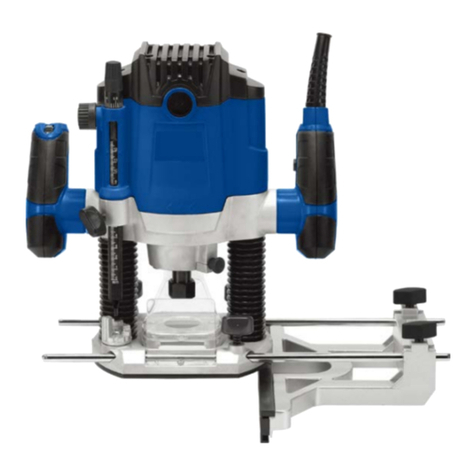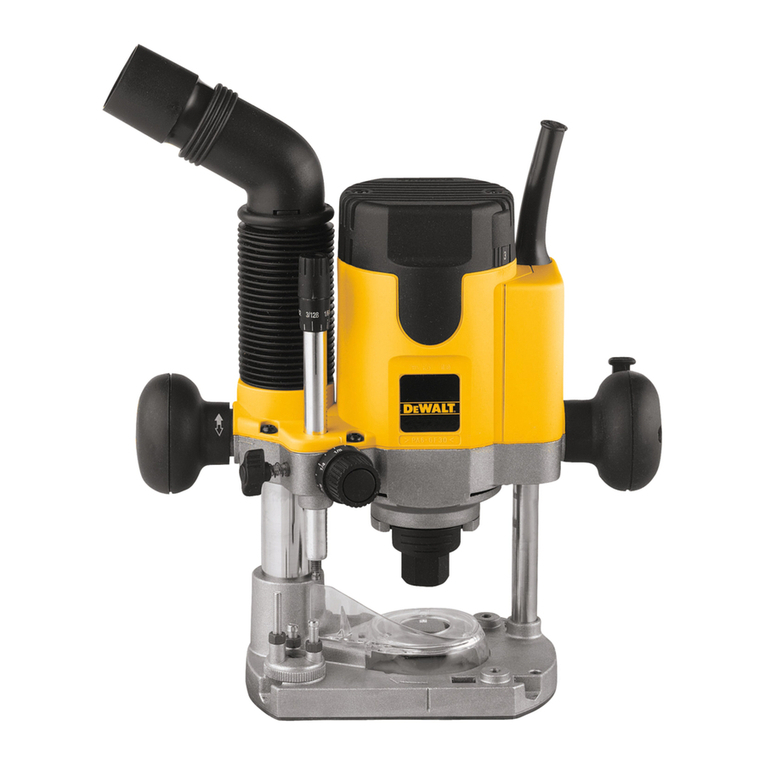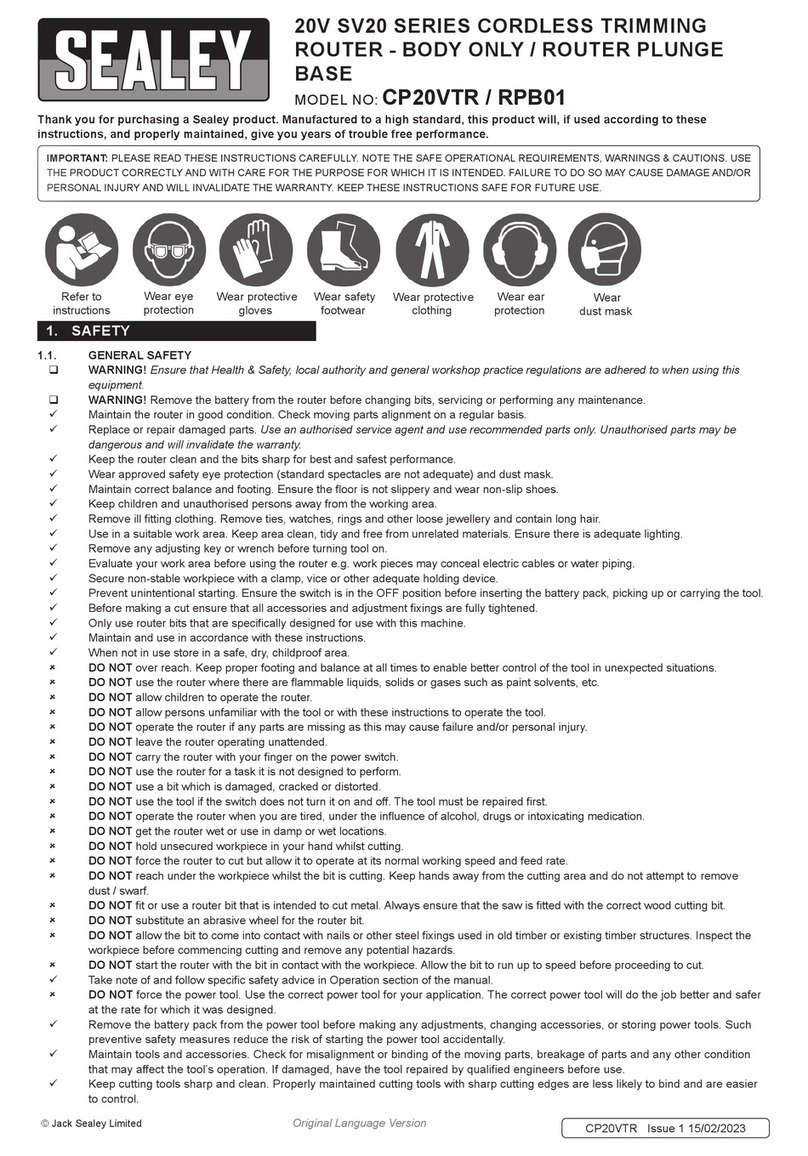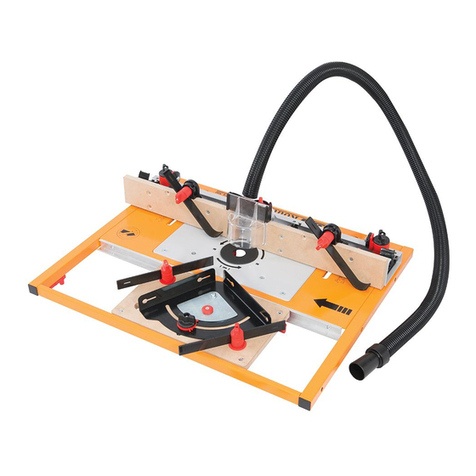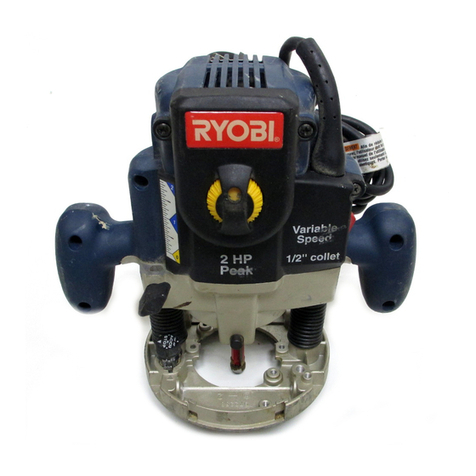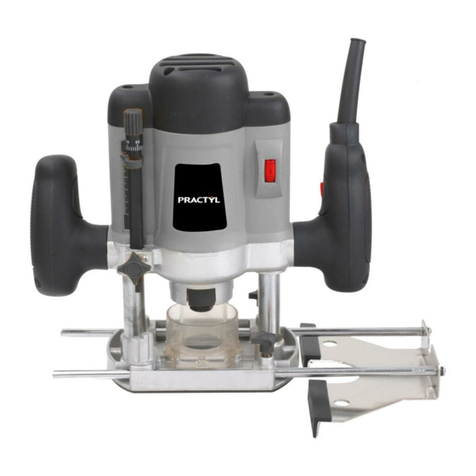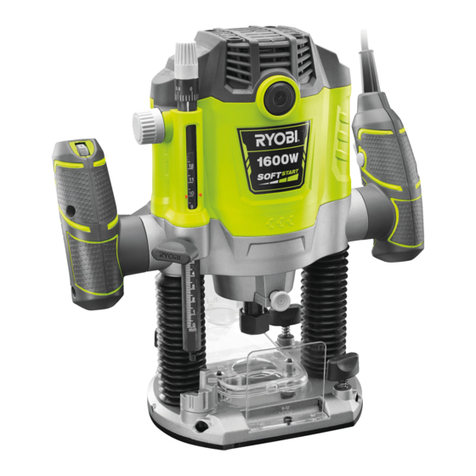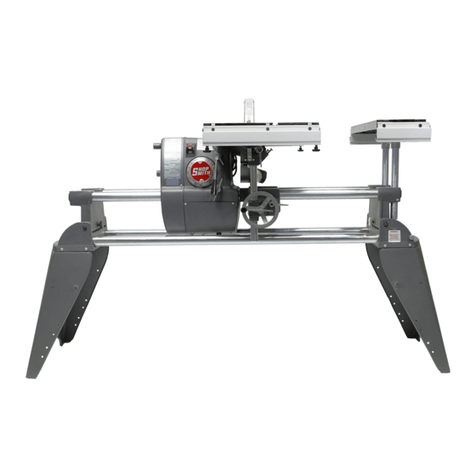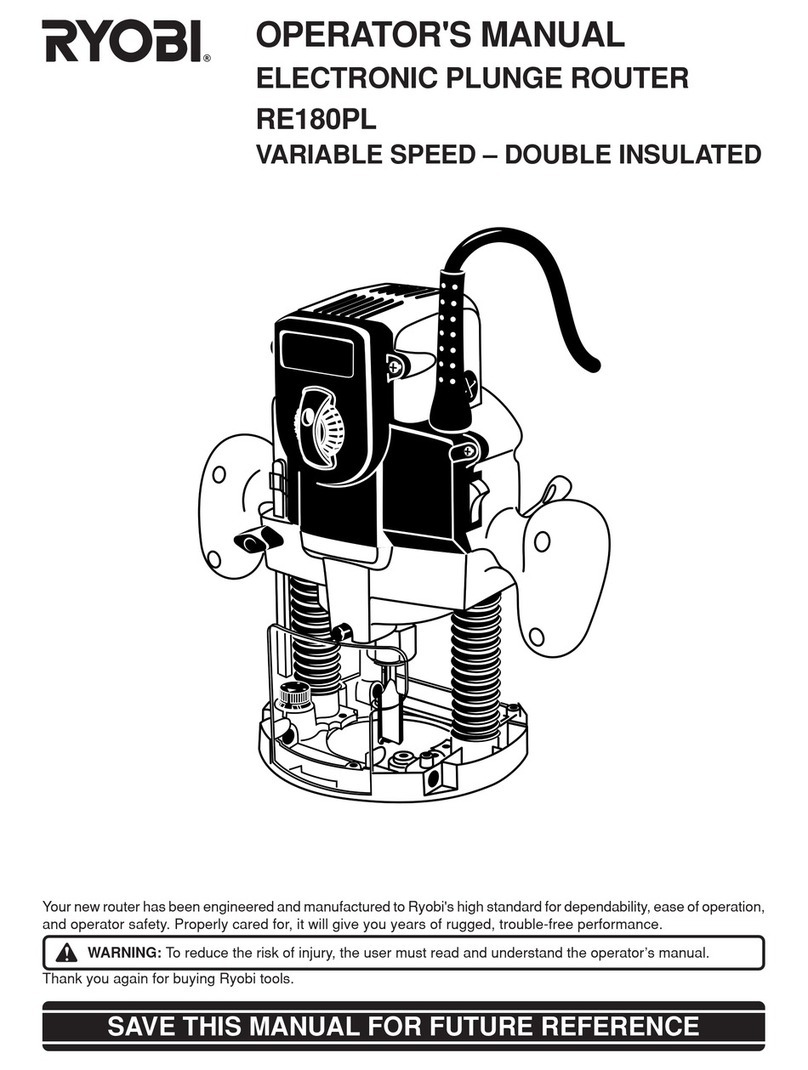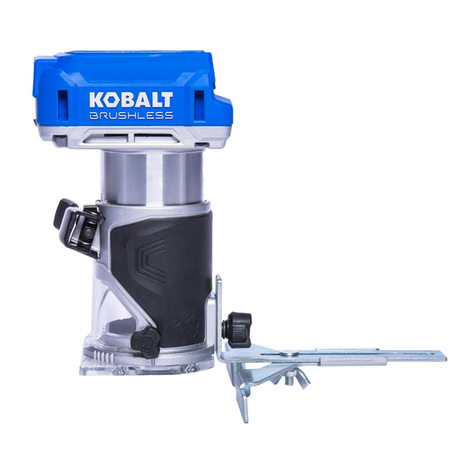Draper 02519 User manual

230V
ROUTER
02519, 02520
These instructions accompanying the product are the original instructions. This document is part of the product, keep
it for the life of the product passing it on to any subsequent holder of the product. Read all these instructions before
assembling, operating or maintaining this product.
This manual has been compiled by Draper Tools describing the purpose for which the product has been designed,
and contains all the necessary information to ensure its correct and safe use. By following all the general safety
instructions contained in this manual, it will ensure both product and operator safety, together with longer life of the
product itself.
All photographs and drawings in this manual are supplied by Draper Tools to help illustrate the operation of the
product.
Whilst every effort has been made to ensure the accuracy of information contained in this manual, the Draper Tools
policy of continuous improvement determines the right to make modications without prior warning.

1.1 INTRODUCTION:
USER MANUAL FOR: 230V Router
Stock No’s: 02519, 02520
Part No’s: R8/1200D, R12/1800D
1.2 REVISIONS:
Date first published July 2021.
As our user manuals are continually updated, users should make
sure that they use the very latest version.
Downloads are available from: http://drapertools.com/manuals
Draper Tools Limited
Hursley Road
Chandler’s Ford
Eastleigh
Hampshire
SO53 1YF
UK
Website: drapertools.com
Product Help Line: +44 (0) 23 8049 4344
General Fax: +44 (0) 23 8026 0784
1.3 UNDERSTANDING THIS MANUALS SAFETY CONTENT:
Warning! – Information that draws attention to the risk of injury or death.
Important – Information that draws attention to the risk of damage to the product or surroundings.
1.4 COPYRIGHT © NOTICE:
Copyright © Draper Tools Limited.
Permission is granted to reproduce this publication for personal and educational use only.
Commercial copying, redistribution, hiring or lending is prohibited.
No part of this publication may be stored in a retrieval system or transmitted in any other form or
means without written permission from Draper Tools Limited.
In all cases this copyright notice must remain intact.
1. TITLE PAGE
– 2 –

2. CONTENTS
– 3 –
2.1 TABLE OF CONTENTS
1. TITLE PAGE
1.1 INTRODUCTION:......................................................................................................... 2
1.2 REVISIONS:................................................................................................................. 2
1.3 UNDERSTANDING THIS MANUALS SAFETY CONTENT:......................................... 2
1.4 COPYRIGHT © NOTICE:............................................................................................. 2
2. CONTENTS
2.1 TABLE OF CONTENTS ............................................................................................... 3
3. WARRANTY
3.1 WARRANTY................................................................................................................. 4
4. INTRODUCTION
4.1 SCOPE......................................................................................................................... 5
4.2 SPECIFICATION.......................................................................................................... 5
4.3 HANDLING AND STORAGE........................................................................................ 5
5. HEALTH AND SAFETY INFORMATION
5.1 GENERAL SAFETY INSTRUCTIONS FOR POWER TOOL USE............................... 6
5.2 SPECIFIC SAFETY INSTRUCTIONS FOR ROUTER USE. ....................................... 7
5.3 RESIDUAL RISK.......................................................................................................... 8
5.4 CONNECTION TO THE POWER SUPPLY ................................................................. 9
6. TECHNICAL DESCRIPTION
6.1 IDENTIFICATION....................................................................................................... 10
7. UNPACKING AND CHECKING
7.1 PACKAGING ...............................................................................................................11
7.2 WHAT’S IN THE BOX .................................................................................................11
8. PREPARING THE ROUTER
8.1 PARALLEL GUIDE FENCE........................................................................................ 12
8.2 DUST EXTRACTION PORT ADAPTOR .................................................................... 12
8.3 DUST EXTRACTION ................................................................................................. 12
8.4 PROTECTIVE SAFETY SCREEN
................................................................................ 13
8.5 FITTING & REPLACING ROUTER BITS................................................................... 13
9. BASIC ROUTER OPERATIONS
9.1 TRIGGER SWITCH.................................................................................................... 14
9.2 VARIABLE SPEED DIAL............................................................................................ 14
9.3 SETTING THE CUTTING DEPTH ............................................................................. 14
9.4 PARALLEL GUIDE ROUTING ................................................................................... 15
9.5 TEMPLATE FOLLOWER ........................................................................................... 15
9.6 PIVOT ROD TRAMMEL............................................................................................. 16
9.7 CURVED EDGE GUIDE ............................................................................................ 16
10. MAINTENANCE AND TROUBLESHOOTING
10.1 MAINTENANCE......................................................................................................... 17
10.2 TROUBLESHOOTING GUIDE................................................................................... 17
11. DISPOSAL
11.1 DISPOSAL ................................................................................................................. 18
12. EXPLANATION OF SYMBOLS
12.1 EXPLANATION OF SYMBOLS.................................................................................. 19

3. WARRANTY
– 4 –
3.1 WARRANTY
Draper tools have been carefully tested and inspected before shipment and are guaranteed to be
free from defective materials and workmanship.
Should the tool develop a fault, please return the complete tool to your nearest distributor or
contact:
Draper Tools Limited, Chandler’s Ford, Eastleigh, Hampshire, SO53 1YF. England.
Telephone Sales Desk: +44 (0) 8049 4333 or Product Help Line +44 (0) 23 8049 4344.
A proof of purchase must be provided with the tool.
If upon inspection it is found that the fault occurring is due to defective materials or workmanship,
repairs will be carried out free of charge. This warranty period covering parts/labour is 12 months
from the date of purchase except where tools are hired out when the warranty period is 90 days
from the date of purchase. This warranty does not apply to any consumable parts, any type of
battery or normal wear and tear, nor does it cover any damage caused by misuse, careless or
unsafe handling, alterations, accidents, or repairs attempted or made by any personnel other than
the authorised Draper warranty repair agent.
Note: If the tool is found not to be within the terms of warranty, repairs and carriage charges will
be quoted and made accordingly.
This warranty applies in lieu of any other warranty expressed or implied and variations of its terms
are not authorised.
Your Draper warranty is not effective unless you can produce upon request a dated receipt or
invoice to verify your proof of purchase within the warranty period.
Please note that this warranty is an additional benet and does not affect your statutory rights.
Draper Tools Limited.

4. INTRODUCTION
4.1 SCOPE
This hand held power tool is ideal for shaping woodwork, cabinetry, architrave, morticing and other
associated routing work.
This product is suitable for enthusiasts and tradespersons alike. Any application other than that it
was intended for is considered misuse.
4.2 SPECIFICATION
Stock No’s. ............................................................ 02519...................................................... 02520
Part No’s. ............................................................ R8/1200D........................................... R12/1800D
Rated voltage .................................................... 230V~50Hz ........................................ 230V~50Hz
Rated input ........................................................... 1200W ....................................................1800W
Collets ......................................................... 6mm, 8mm and 1⁄4".....................1⁄4", 1⁄2", and 12mm
Plunge stroke.......................................................... 55mm...................................................... 50mm
Speed (no load) ......................................... 11,000 – 30,000r/min .................... 6,000 – 22,000r/min
Sound Pressure Level .......................................... 88dB(A) ................................................. 96dB(A)
Sound Power Level .............................................. 99dB(A) ............................................... 107dB(A)
Uncertainty (K): ............................................. 3dB(A)..................................................... 3dB(A)
Vibration level ....................................................... 3.6m/s²................................................... 3.6m/s²
Uncertainty (K): .............................................1.5m/s² ................................................... 1.5m/s²
Weight ..................................................................... 4kg ..........................................................7.5kg
4.3 HANDLING AND STORAGE
−Care must be taken when handling this product.
• Dropping this power tool could have an effect on its accuracy and could also result in
personal injury. This product is not a toy and must be respected.
−Environmental conditions can have a detrimental effect on this product if neglected.
• Exposure to damp air can gradually corrode components. If the product is unprotected from
dust and debris, components will become clogged.
• If not cleaned and maintained correctly or regularly, the machine will not perform at its best.
– 5 –

5. HEALTH AND SAFETY INFORMATION
5.1 GENERAL SAFETY INSTRUCTIONS FOR POWER TOOL USE
Warning! Read all safety warnings, instructions, illustrations and specifications provided
with this power tool. Failure to follow all instructions listed below may result in electric shock, re
and/or serious injury.
Save all warnings and instructions for future reference.
The term “power tools” in the warnings refers to your mains-operated (corded) power tool or
battery-operated (cordless) power tool.
1) Work area safety
a) Keep work area clean and well lit. Cluttered or dark areas invite accidents.
b) Do not operate power tools in explosive atmospheres, such as in the presence of
flammable liquids, gases or dust. Power tools create sparks which may ignite the dust or
fumes.
c) Keep children and bystanders away while operating a power tool. Distractions can
cause you to lose control.
2) Electrical safety
a) Power tool plugs must match the outlet. Never modify the plug in any way. Do not
use any adapter plugs with earthed (grounded) power tools. Unmodied plugs and
matching outlets will reduce risk of electric shock.
b) Avoid body contact with earthed or grounded surfaces, such as pipes, radiators,
ranges and refrigerators. There is an increased risk of electric shock if your body is
earthed or grounded.
c) Do not expose power tools to rain or wet conditions. Water entering a power tool will
increase the risk of electric shock.
d) Do not abuse the cord. Never use the cord for carrying, pulling or unplugging the
power tool. Keep cord away from heat, oil, sharp edges or moving parts. Damaged or
entangled cords increase the risk of electric shock.
e) When operating a power tool outdoors, use an extension cord suitable for outdoor
use. Use of a cord suitable for outdoor use reduces the risk of electric shock.
f) If operating a power tool in a damp location is unavoidable, use a residual current
device (RCD) protected supply. Use of an RCD reduces the risk of electric shock.
3) Personal safety
a) Stay alert, watch what you are doing and use common sense when operating a
power tool. Do not use a power tool while you are tired or under the influence of
drugs, alcohol or medication. A moment of inattention while operating power tools may
result in serious personal injury.
b) Use personal protective equipment Always wear eye protection. Protective equipment
such as a dust mask, non-skid safety shoes, hard hat or hearing protection use for
appropriate conditions will reduce personal injuries.
c) Prevent unintentional starting. Ensure the switch is in the off-position before
connecting to power source and/or battery pack, picking up or carrying the tool.
Carrying power tools with your nger on the switch or energising power tools that have the
switch on invites accidents.
d) Remove any adjusting key or wrench before turning the power tool on. A wrench or a
key left attached to a rotating part of the power tool may result in personal injury.
e) Do not overreach. Keep proper footing and balance at all times. This enables better
control of the power tool in unexpected situations.
– 6 –

5. HEALTH AND SAFETY INFORMATION
f) Dress properly. Do not wear loose clothing or jewellery. Keep your hair and clothing
away from moving parts. Loose clothes, jewellery or long hair can be caught in moving
parts.
g) If devices are provided for the connection of dust extraction and collection facilities,
ensure these are connected and properly used. Use of dust collection can reduce
dust-related hazards.
h) Do not let familiarity gained from frequent use of tools allow you to become
complacent and ignore tool safety principles. A careless action can cause severe injury
within a fraction of a second.
4) Power tool use and care
a) Do not force the power tool. Use the correct power tool for your application. The
correct power tool will do the job better and safer at the rate for which it was designed.
b) Do not use the power tool if the switch does not turn it on and off. Any power tool that
cannot be controlled with the switch is dangerous and must be repaired.
c) Disconnect the plug from the power source and/or remove the battery pack, if
detachable, from the power tool before making any adjustments, changing
accessories, or storing power tools. Such preventive safety measures reduce the risk of
starting the power tool accidentally.
d) Store idle power tools out of the reach of children and do not allow persons
unfamiliar with the power tool or these instructions to operate the power tool. Power
tools are dangerous in the hands of untrained users.
e) Maintain power tools and accessories. Check for misalignment or binding of moving
parts, breakage of parts and any other condition that may affect the power tool’s
operation. If damaged, have the power tool repaired before use. Many accidents are
caused by poorly maintained power tools.
f) Keep cutting tools sharp and clean. Properly maintained cutting tools with sharp cutting
edges are less likely to bind and are easier to control.
g) Use the power tool, accessories and tool bits etc. in accordance with these
instructions, taking into account the working conditions and the work to be
performed. Use of the power tool for operations different from those intended could result
in a hazardous situation.
h) Keep handles and grasping surfaces dry, clean and free from oil and grease. Slippery
handles and grasping surfaces do not allow for safe handling and control of the tool in
unexpected situations.
5) Service
a) Have your power tool serviced by a qualified repair person using only identical
replacements parts. This will ensure that the safety of the power tool is maintained.
5.2 SPECIFIC SAFETY INSTRUCTIONS FOR ROUTER USE.
a) Hold power tool by insulated gripping surfaces, when performing an operation where the
cutting accessory may contact hidden wiring or its own cord. Cutting accessory contacting
a “live” wire may make exposed metal parts of the power tool “live” and could give the
operator an electric shock.
b) Always wear a dust mask and ear protection when using this power tool.
c) Use only bits, which are designed for this router.
d) Use only sharp bits that are not chipped or cracked. Blunt bits will cause stalling.
e) Secure small pieces of wood rmly before working. Never hold them in your hand.
f) Danger. Keep hands away from the cutting area.
– 7 –

5. HEALTH AND SAFETY INFORMATION
g) Secure the workpiece by means of the clamping equipment.
h) Before staring up, check that the bit is rmly positioned and secured into the collets.
i) The maximum indicated limit rotation speed of the milling bit must not be exceeded.
j) Routing must always be carried out against the direction of rotation (bit-rotation) of the bit.
k) The bit must be running at full speed before lowering into the workpiece.
l) When operating the machine, take great care and always hold the router handles rmly
with both hands. Always provide for a secure footing when working.
m) Beware of the reaction torque of the machine, particularly if the bit becomes jammed in the
workpiece.
n) On completion of work, allow the machine to slide back to its initial position by releasing the
handle.
o) Make yourself familiar with your working area and be alert for possible hazards, which you
might not hear due to machine noise.
p) Caution: Allow for run down time of bit after turning router off. Wait for the machine to come
to a complete stop before removing from the workpiece.
q) Never slow the router down with your hands.
r) Do not touch the bit immediately after operation; it may be extremely hot and could burn
you.
s) Never stop the router by applying lateral pressure to the bit.
t) Do not force the router. Your router will do a better job if you take it slowly.
u) Avoid cutting nails and screws. Inspect timber and remove all nails and screws before
cutting.
v) In the event of an electrical or mechanical malfunction, immediately switch off the router
and disconnect the power lead from the mains supply, and contact Draper for assistance.
5.3 RESIDUAL RISK
Important: Although the safety instructions and operating manuals for our tools contain extensive
instructions of safe working with power tools, every power tool involves a certain residual risk
which can not be completely excluded by safety mechanisms. Power tools must therefore always
be operated with caution!
– 8 –

5. HEALTH AND SAFETY INFORMATION
– 9 –
5.4 CONNECTION TO THE POWER SUPPLY
Caution: Risk of electric shock. Do not open.
This appliance is supplied with an approved plug and cable for your safety. The value of the fuse
tted is marked on the pin face of the plug. Should the fuse need replacing, ensure the substitute
is of the correct rating, approved to BS1362 and ASTA or BS Kite marked.
ASTA
BSI
The fuse cover is removable with a small plain slot screwdriver. Ensure the fuse cover is replaced
before attempting to connect the plug to an electrical outlet. If the cover is missing, a replacement
must be obtained or the plug replaced with a suitable type.
If a replacement plug is to be tted this must be carried out by a qualied electrician.
The damaged or incomplete plug, when cut from the cable should be disabled to prevent
connection to a live electrical outlet.
This appliance is Class II† and is designed for connection to a power supply matching that detailed
on the rating label and compatible with the plug tted.
If an extension lead is required, use an approved and compatible lead rated for this appliance.
Follow all the instructions supplied with the extension lead.
†Double insulated
: This product requires no earth connection as supplementary insulation is
applied to the basic insulation to protect against electric shock in the event of failure of the basic
insulation.
IMPORTANT
If using an extension lead, follow the instructions that came with your lead regarding
maximum load while cable is wound. If in doubt, ensure that the entire cable is unwound.
Using a coiled extension lead will generate heat which could melt the lead and cause a fire.

6. TECHNICAL DESCRIPTION
– 10 –
6.1 IDENTIFICATION
(1) ON/OFF trigger switch.
(2) Trigger safety button.
(3) Plunge lock lever.
(4) Variable speed control.
(5) Fine height adjustment.
(6) Depth guide locking screw.
(7) Dust extraction adaptor.
(8) Adjustable turret depth stop.
(9) Parallel guide locking screw.
(10) Collet nut.
(11) Power cable and plug.
(12) Depth adjustment dial (02520 only).
(13) Spindle lock button.
(14) Protective safety screen.
(1)
(2)
(8) (8)
(7) (7)
(4)
(4)
(5)
(11) (11)
(12)
(5)
(10) (14) (14)
(10)
(13)
(13)
(9)
(9)
(6) (6)
Stock No. 02520Stock No. 02519
(3)

7.1 PACKAGING
Carefully remove the product from the packaging and examine it for any sign of damage that may
have happened during shipping. Lay the contents out and check them against the parts shown
below. If any part is damaged or missing, please contact the Draper Help Line (the telephone
number appears on the Title page) and do not attempt to use the product.
The packaging material should be retained at least during the warranty period, in case the
machine needs to be returned for repair.
Warning!
−Some of the packaging materials used may be harmful to children. Do not leave any of these
materials in the reach of children.
−If any of the packaging is to be thrown away, make sure they are disposed of correctly,
according to local regulations.
7.2 WHAT’S IN THE BOX
As well as the main product, there are several parts not tted or attached to it.
(20)
7. UNPACKING AND CHECKING
– 11 –
(15) Spanner.
(16) Template follower.
(17) Parallel guide fence.
(19) Collets: 6mm, 8mm and 1⁄4".
(8mm collet factory tted).
(20) Pivot rod trammel (circle guide).
(15) Spanner.
(16) Template follower.
(17) Parallel guide fence.
(18) Curved edge guide.
(19) Collets: 1⁄2", 1⁄ 4" and 12mm
(12mm collet factory tted).
(20) Pivot rod trammel (circle guide).
Stock No. 02520Stock No. 02519
Note: For details of our full range of accessories and consumables, please visit drapertools.com
(16)
(16)
(19) (19)
(20)
(17)
(17)
(15) (15)
(18)

– 12 –
8. PREPARING THE ROUTER
Note: Remove the plug from the socket before
carrying out adjustment, servicing or maintenance.
8.1 PARALLEL GUIDE FENCE – FIG. 1
−If not already assembled, loosen the 2 fence
locking screws (17.1)on the parallel guide body
and slide the 2 guide rods (17.2)though the
mounting holes.
−Tighten the fence locking screws to hold the
rods in place to the parallel guide fence.
−Loosen the 2 parallel guide locking screws (9)
located on the base of the machine.
− Feed the parallel guide fence and rods through
the locating holes and channels on the base of
the machine (9.1).
−Adjust the cutting distance according to the job
in hand and then tighten the parallel guide
locking screws (9)to secure.
8.2 DUST EXTRACTION PORT
ADAPTOR – FIG. 2
Note: The majority of operations will require the
dust extraction port to be tted. However, some
operations will be impossible with the port tted.
These require appropriate safety equipment to be
worn.
If not already tted in place:
−Locate the dust extraction port adaptor (7) into position on the machine base.
− Thread the two supplied xings up through the base and into the nuts set into the port.
Note: Be careful to secure the port without damaging the plastic parts by over tightening the
machine screws.
8.3 DUST EXTRACTION
Inhalation of dust particles can be detrimental to health. The dust outlet (7) must be connected
with a dust extraction machine.
Note: Due to the outlet diameter, a size adaptation may be necessary.
Warning! All wood dust (including dust from composites like chipboards and bre boards etc) is
hazardous to health; it can affect the nose, the respiratory system and the skin. For example MDF
(medium density breboard) which contains formaldehyde is a known carcinogen. In addition to
the above measures a correctly tted dust mask, suitable for the activity and in accordance to the
relevant standard, must be worn. For work activities involving exposure to ne wood dust a mask
rated to at least FFP2 should be used.
1
2
FIG.
FIG.
(17.1)
(17)
(7)
(9)(9.1)
(17.2)

3
4
FIG.
FIG.
8. PREPARING THE ROUTER
8.4 PROTECTIVE SAFETY SCREEN
–
FIG. 3
If not already in place, slot the screen (14)into the
recess and fasten, using the screw provided.
8.5 FITTING & REPLACING ROUTER
BITS – FIG. 4
• Stock No.02519 is designed for use with 6mm,
8mm and 1 ⁄ 4" shank router bits only.
• Stock No.02520 is designed for use with 1⁄ 4”,
1 ⁄ 2”, and 12mm shank router bits only.
Warning! Use bits of the correct shank diameter
suitable for the speed of the tool.
Selection of the correct router bit, suitable for the
intended application is vital. Seek guidance if
uncertain of selection.
Press the spindle lock button (13) and unscrew the
collet nut (10) using the spanner (15)supplied.
Note: Take care not to loose the spring behind the
collet.
From the collets provided, choose the appropriate
size for the cutters shank. If the size is not known
insert the bit into the collet. The collet which offers
a machine t to the shank is the correct one to
use. Do not force the bit into a collet.
Replace the spring and place the collet into the
spindle before loosely replacing the nut (10).
Slide in the bit allowing approx. 5-10mm overhang
before tighten the collet nut (observe the router
bit’s manufacturers instructions for more specic
information).
Note: Ensure at least 75% of the shank is inside
the collet. Do not tighten the collet with no bit tted
as this will cause damage.
Do not over-tighten the collet nut.
Warning! Take care when handling the cutter bits
as they are extremely sharp.
When cutting is complete remove the bit before
cleaning and storing it in a safe place.
– 13 –
(14)
(15)
(13)
(10)

– 14 –
9. BASIC ROUTER OPERATIONS
Note: Remove the plug from the socket before
carrying out adjustment, servicing or maintenance.
9.1 TRIGGER SWITCH – FIG. 5
The router is tted with a safety lock off switch to
prevent accidental starting. Press and hold lock
button (2). Pull trigger (1) and the router will start.
9.2 VARIABLE SPEED DIAL – FIG. 6
• Stock No.02519
The variable speed dial is marked 1 to MAX and
corresponds to the table below:
Setting Speed
1Low speed
2
3Medium speed
4
5
High speed6
MAX
Note: Cutting speed depends on material, cutter
size, cutting depth etc. Larger router bits will
require a slower speed. For more detailed
information refer to routing/woodworking reference
material.
9.3 SETTING THE CUTTING DEPTH –
FIGS. 7 – 8
− With a suitable router bit tted place the router
on to the workpiece. Rotate the turret (8) to the
lowest position. Slowly plunge the router until
the bit just touches the workpiece. Lock the
router in this position with the plunge lock lever
(3).
−Ensure the depth guide locking screw (6) is not
tight and lower the rod (6.1) until it touches the
turret. If necessary turn the ne height
adjustment control (5) to align the nearest digit
on the scale against the pointer (6.2).
−Take note of the setting before raising the rod
upward to set the plunge depth (the difference
between the two measurements) and securely
tighten the depth guide locking screw (6).
Example: The scale reads 23. After adjustment
reads 33 – the plunge depth will be 10mm.
5
6
FIG.
FIG.
7FIG.
(2)
(2)
(5)
(6.1)
(6)
(6.2)
(8)
(1)
Stock No. 02520
Stock No. 02519

– 15 –
9. BASIC ROUTER OPERATIONS
Release the plunge lock lever and raise the router
back to full height. Rotate the turret round several
positions and the router is set up ready to begin
work.
When beginning to cut, plunge the cutter slowly to
the rst depth and proceed with the cut. Take a
second pass at the next step down on the turret and
continue until the full depth is achieved.
Regulate the depth of the cut and speed of feed to
ensure no strain is put on to the cutter or motor,
however if the speed is too slow, burn marks may
appear on the workpiece.
Note: The direction of rotation is marked on the
machine housing above the spindle stop
mechanism. Travelling along a workpiece in the
wrong direction will cause the bit to pull and bounce,
leading to a poor nish and possible damage.
−If, after the full depth has been routed, further
material removal is necessary lock the router in
the plunged position.
− Rotate the ne height adjustment control (5).
− Turning the ne adjustment anti-clockwise will
increase the plunge depth. One complete turn is
equivalent to 1mm plunge depth. When set, take
another pass along the cut.
Note: Remove the plug from the socket before
carrying out adjustment, servicing or maintenance.
9.4 PARALLEL GUIDE ROUTING –
FIG. 9
Ensure the edge along which the guide is going to
travel is smooth and true as any inconsistencies will
translate into the cut.
• See section 8.1 PARALLEL GUIDE FENCE on
page 12 for assembly instructions.
When using the parallel guide an even pressure
should be applied to each face except on a leading/
trailing edge of a workpiece. When leading on to a
workpiece apply the pressure to the forward face
until both faces are on. When trailing off a workpiece apply the pressure to the rear face until the
cut is complete.
9.5 TEMPLATE FOLLOWER – FIG. 10
For detailed information on templates refer to a routing/woodworking book.
−Lay the template follower (16) into the recess. Ensure the template follower faces downward
and secure with the two countersunk screws (16.1).
Warning! Whilst this router is capable of cutting kitchen worktops, it should be noted that this is
not a professional machine and therefore its tolerances and performance are not as accurate as a
professional machine.
8
9
10
FIG.
FIG.
FIG.
(16.1)
(16)
(19)
Stock No. 02520
Stock No. 02519

– 16 –
9. BASIC ROUTER OPERATIONS
9.6 PIVOT ROD TRAMMEL – FIG. 11
−Remove one of the 2 rods (17.2)from the
parallel fence guide (17).
−Loosen the parallel fence guide locking screw
(9) from the front channel.
−Insert the rod into the rod channel.
−Loosen the trammel wing nut (20.1)and slide
the trammel (20) on to the end of the rod.
−Adjust the point height to suit before locking the
trammel wing nut (20.1).
−Adjust the distance between the router bit and
pivot point by sliding the rod to suit the
diameter of the circle/hole required.
−Tighten the parallel fence guide locking knob to
secure.
9.7 CURVED EDGE GUIDE
(02520 only) – FIGS. 12 – 14
An optional attachment that attaches to the parallel
fence guide, the curved edge guide (18)can be
used to follow shaped contours of timber.
−Remove the black guards (17.1)from the
parallel guide fence (17)by removing the 4
screws holding them in place.
−Retaining 2 of the above screws, use them to
secure the curved edge guide (18)to the
parallel fence guide (Fig.13).
−When cutting, ride the guide wheel along the
contour of the workpiece to make the cut
(Fig.14).
Note: It’s essential that the guide wheel of the
curved edge guide is kept free of dust and swarf to
enable it to freely rotate. Use a suitable lubricant, if
required.
11
12
13
14
FIG.
FIG.
FIG.
FIG.
(17.2)
(18)
(9)
(20)
(17)
(20.1)
(17.1)

10. MAINTENANCE AND TROUBLESHOOTING
– 17 –
10.1 MAINTENANCE
Regular inspection and cleaning reduces the necessity for maintenance operations and will keep
your tool in good working condition.
The motor must be correctly ventilated during tool operation. Avoid blocking the air inlets and
vacuum the ventilation slots regularly.
10.2 TROUBLESHOOTING GUIDE
Problem Possible Cause Remedy
Motor does not start. 1. Fuse.
1. Replace/reset 13 amp
time delay fuse or circuit
breaker.
2. Brushes worn. 2. Return to an authorised
service agent for brushes
replacement.
3. Unsure. 3. Return to an authorised
service agent for
diagnosis.
Machine vibrates. 1. Router bit not suitable for
application.
2. Seek guidance on bit
selection.
2. Router bit blunt. 2. When machine has
stopped, replace bit.
3. Incorrect direction of
travel.
3. Change direction of travel.
Bit will not cut. 1. Attempting to remove
excess material.
3. Reduce plunge depth.
2. Router bit blunt. 2. When machine has
stopped, replace bit.
3. Incorrect direction of
travel.
3. Change direction of travel.
Important: All repairs/servicing should be carried out by a qualied person.

11. DISPOSAL
11.1 DISPOSAL
– At the end of the machine’s working life, or when it can no longer be repaired, ensure that it is
disposed of according to national regulations.
– Contact your local authority for details of collection schemes in your area.
In all circumstances:
• Do not dispose of power tools with domestic waste.
• Do not incinerate.
• Do not dispose of WEEE* as unsorted municipal waste.
* Waste Electrical & Electronic Equipment.
– 18 –

12. EXPLANATION OF SYMBOLS
– 19 –
12.1 EXPLANATION OF SYMBOLS
Read the instruction manual.
Wear face mask and safety
glasses.
Wear ear defenders.
Do not abandon into the
environment.
Keep out of the reach of children.
Warning!
Rated wattage input.
No-load speed (revolutions
per minute).
Max. plunge depth.
Electrical power supply
cable length.
Net product weight.
Class II construction
(Double insulated).
WEEE –
Waste Electrical & Electronic Equipment.
Do not dispose of Waste Electrical & Electronic
Equipment in with domestic rubbish.
98
dB
Continuous A-Weighted Sound
Pressure Level (example shown).
UK Conformity Assessed.
European conformity.

CONTACTS
Draper Tools Limited, Hursley Road,
Chandler’s Ford, Eastleigh, Hampshire. SO53 1YF. U.K.
Help Line: (023) 8049 4344
Sales Desk: (023) 8049 4333
Internet: drapertools.com
E-mail: [email protected]
General Enquiries: (023) 8026 6355
Service/Warranty Repair Agent:
For aftersales servicing or warranty repairs, please contact the
Draper Tools Help Line for details of an agent in your local area.
YOUR DRAPER STOCKIST
TACH0721
©Published by Draper Tools Limited.
No part of this publication may be reproduced, stored in a retrieval system or transmitted in any form or by any means,
electronic, mechanical photocopying, recording or otherwise without prior permission in writing from Draper Tools Ltd.
Other manuals for 02519
1
This manual suits for next models
1
Table of contents

